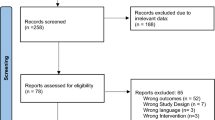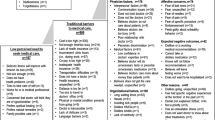Abstract
Timely access to medical care is important for HIV+ individuals. Standards of care are needed that identify inappropriate delays in receiving care for serious symptoms. We evaluated the reliability and construct validity of provider-based standards for timely care for HIV symptoms, and applied these standards to data from the HIV Cost and Services Utilization Study (HCSUS), a national probability sample of HIV+ persons in care. HIV physicians estimated appropriate time to care HIV+ individuals should receive for headache, cough, diarrhea, or weight loss. Timely care was defined as receiving care by the mean provider-specified acceptable number of days to care, by specific CD4 count, compared to receiving care after the mean days to care. Sensitivity analyses were performed on the provider standards. Inter-rater reliability between physicians for timely care estimates was high (0.97). Up to 70% of HIV+ individuals from the HCSUS survey did not receive timely care for their most bothersome symptom. Physicians rated patients with lower CD4 counts (<200 cells/ml) as requiring care within a shorter period of time. However, patients with lower CD4 counts (<200 cells/ml) were no more likely or less likely to receive timely care. Physicians considered headache and cough more urgent than weight loss. Yet patients with headache or cough were the least likely to receive timely care. In a national probability sample, time to care for a majority of HIV patients for their most bothersome symptoms exceeded provider-based standards. Further research is needed on reasons for this mismatch.
Similar content being viewed by others
References
D. W. Baker, M. F. Shapiro and C. L. Schur, “Health insurance and access to care for symptomatic conditions,” Arch. Intern. Med., 160, pp. 1269–1274, 2000.
D. W. Baker, M. F. Shapiro, C. L. Schur and H. Freeman, “A revised measure of symptom-specific health care use,” Soc. Sci. Med., 47, pp. 1601–1609, 1998.
M. L. Berk and C. L. Schur, “Measuring access to care: improving information for policymakers,” Health Aff., 17, pp. 180–186, 1998.
E. Berkanovic, M. L. Hurwicz and J. Landsverk, “Psychological distress and the decision to seek medical care,” Soc. Sci. Med., 27, pp. 1215–1221, 1988.
P. D. Cleary, F. J. Fowler, J. Weissman, M. P. Massagli, I. Wilson, G. R. Seage 3rd, C. Gatsonis and A. Epstein, “Health-related quality of life in persons with acquired immune deficiency syndrome,” Med. Care, 31, pp. 569–580, 1993.
W. E. Cunningham, H. E. Rana, M. F. Shapiro and R. D. Hays, “Reliability and validity of self-reported CD4 counts in persons hospitalized with HIV disease,” J. Clin. Epidemiol., 50, pp. 829–835, 1997.
W. E. Cunningham, M. F. Shapiro, R. D. Hays, W. J. Dixon, B. R. Visscher, W. L. George, M. K. Ettl and C. K. Beck, “Constitutional Symptoms and health-related quality of life in patients with symptomatic HIV disease,” Am. J. Med., 104, pp. 129–136, 1998.
R. M. Davis, E. H. Wagner and T. Groves, “Managing chronic disease,” BMJ, 318, pp. 1090–1091, 1999.
M. R. Frankel, M. F. Shapiro, N. Duan, S. C. Morton, S. H. Berry, J. A. Brown, M. A. Burnam, S. E. Cohn, D. P. Goldman, D. F. McCaffrey, S. M. Smith, P. A. St. Clair, J. F. Tebow and S. A. Bozzette, “National probability samples in studies of low-prevalence diseases. Part II: Designing and implementing the HIV Cost and Services Utilization Study sample,” Health Serv. Res., 34, pp. 969–992, 1999.
R. D. Hays, R. T. Anderson and D. Revicki, “Assessing reliability and validity of measurement in clinical trials,” In: M. J. Staquet, R. D. Hays and P. M. Fayers, Eds., Quality of Life Assessment in Clinical Trials: Methods and Practice, New York: Oxford University Press, 169–175, 1998.
M. S. Kramer and A. R. Feinstein, “Clinical biostatistics LIV: the biostatistics of concordance,” Clin. Pharmacol. Ther., 29, pp. 111–123, 1981.
D. A. Leaf, W. E. Neighbor, D. Schaad and C. S. Scott, “A comparison of self-report and chart audit in studying resident physician assessment of cardiac risk factors,” J. Gen. Intern. Med., 10, pp. 194–198, 1995.
D. E. Montano and W. R. Phillips, “Cancer screening by primary care physicians: a comparison of rates obtained from physician self-report, patient survey, and chart audit,” Am. J. Public Health, 85, pp. 795–800, 1995.
M. F. Shapiro, L. Berk, S. H. Berry, C. A. Emmons, L. A. Athey, D. C. Hsia, A. A. Leibowitz, C. A. Maida, M. Marcus, J. F. Perlman, C. L. Schur, M. A. Schuster, J. W. Senterfitt and S. A. Bozzette, “National probability samples in studies of low-prevalence diseases. Part I: perspectives and lessons from the HIV Cost and Services Utilization Study,” Health Serv. Res., 34, pp. 951–968, 1999.
M. F. Shapiro, R. A. Hayward, H. E. Freeman, S. Sudman and C. R. Corey, “Out-of-pocket payments and use of care for serious and minor symptoms: results of a national survey,” Arch. Intern. Med., 149, pp. 1645–1648, 1989.
M. F. Shapiro, J. E. Ware and C. D. Sherbourne, “Effects of cost sharing on seeking care for serious and minor symptoms: results from a randomized controlled trial,” Ann. Intern. Med., 104, pp. 246–251, 1986.
P. E. Shrout and J. L. Fleiss, “Intraclass correlations: uses in assessing rater reliability,” Psychol. Bull., 86, pp. 420–428, 1979.
Stata Corp, Stata 4-Volume Reference Manual Set, College Station: Stata Press, TX, 1999.
D. G. Taylor, L. A. Aday and R. Andersen, “A social indicator of access to medical care,” J. Health Soc. Behav., 16, pp. 39–49, 1975.
B. J. Turner and R. M. Nido, “Urgency in seeking medical care for specific symptoms: perceptions of physicians and patients,” J. Gen. Intern. Med., 3, pp. 245–249, 1988.
T. Wachtel, J. Piette, V. Mor, M. Stein, J. Fleishman and C. Carpenter, “Quality of life in persons with human immunodeficiency virus infection: measurement by the Medical Outcomes Study instrument,” Ann. Intern. Med., 116, pp. 129–137, 1992.
E. H. Wagner, B. T. Austin and M. Von Korff, “Organizing care for patients with chronic illness,” Milbank Quarterly, 74, pp. 511–544, 1996.
E. H. Wagner, “Managed care and chronic illness: health services research needs,” Health Serv. Res., 32, pp. 702–714, 1997.
I. B. Wilson and P. D. Cleary, “Linking clinical variables with health-related quality of life. A conceptual model for patient outcomes,” JAMA, 273, pp. 59–65, 1995.
S. C. Zell and P. H. Goodman, “Urgency of medical care. Contrasting perceptions of HIV-positive patients and physicians,” Arch. Intern. Med., 154, pp. 1857–1862, 1994.
Author information
Authors and Affiliations
Consortia
Rights and permissions
About this article
Cite this article
Kilbourne, A.M., Asch, S., Andersen, R.M. et al. Development and Application of a Method to Assess Timeliness of Medical Care for HIV Symptoms. Health Services & Outcomes Research Methodology 2, 101–115 (2001). https://doi.org/10.1023/A:1020102028911
Issue Date:
DOI: https://doi.org/10.1023/A:1020102028911




